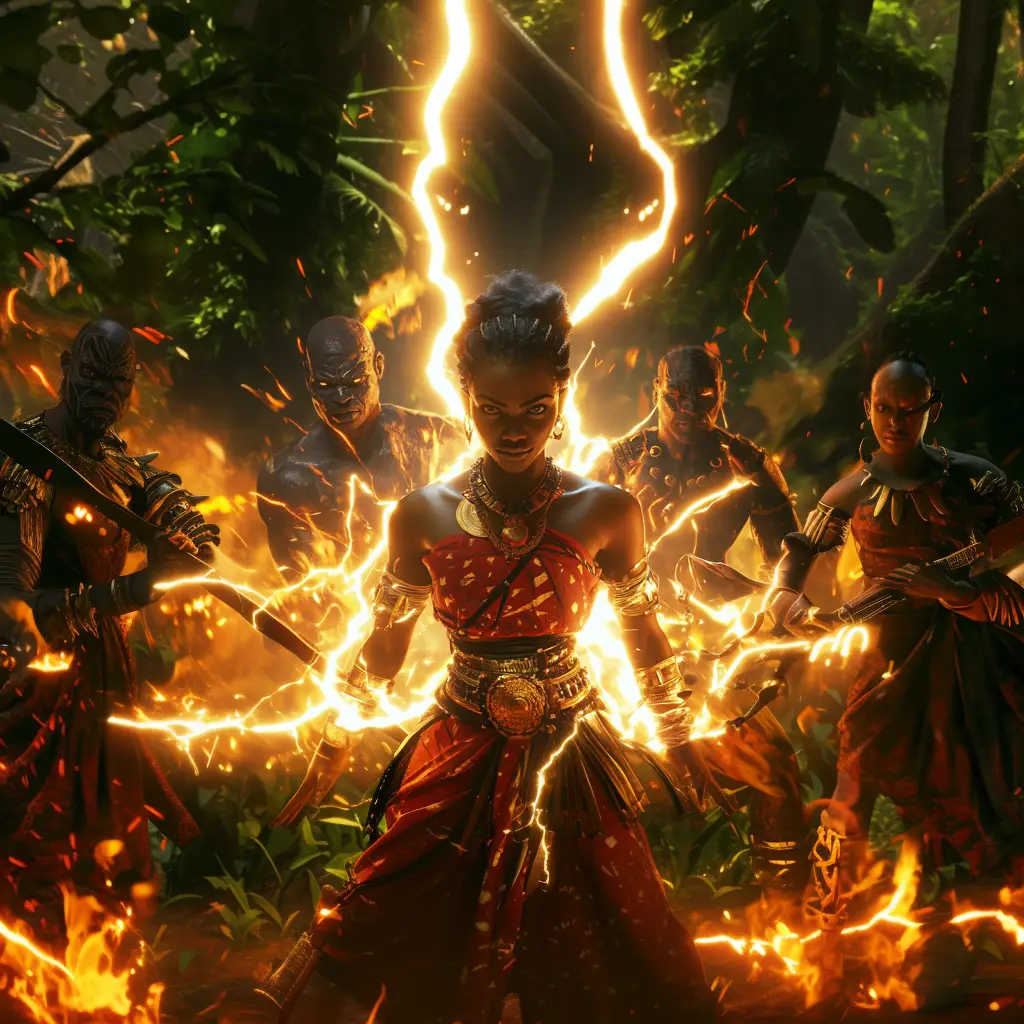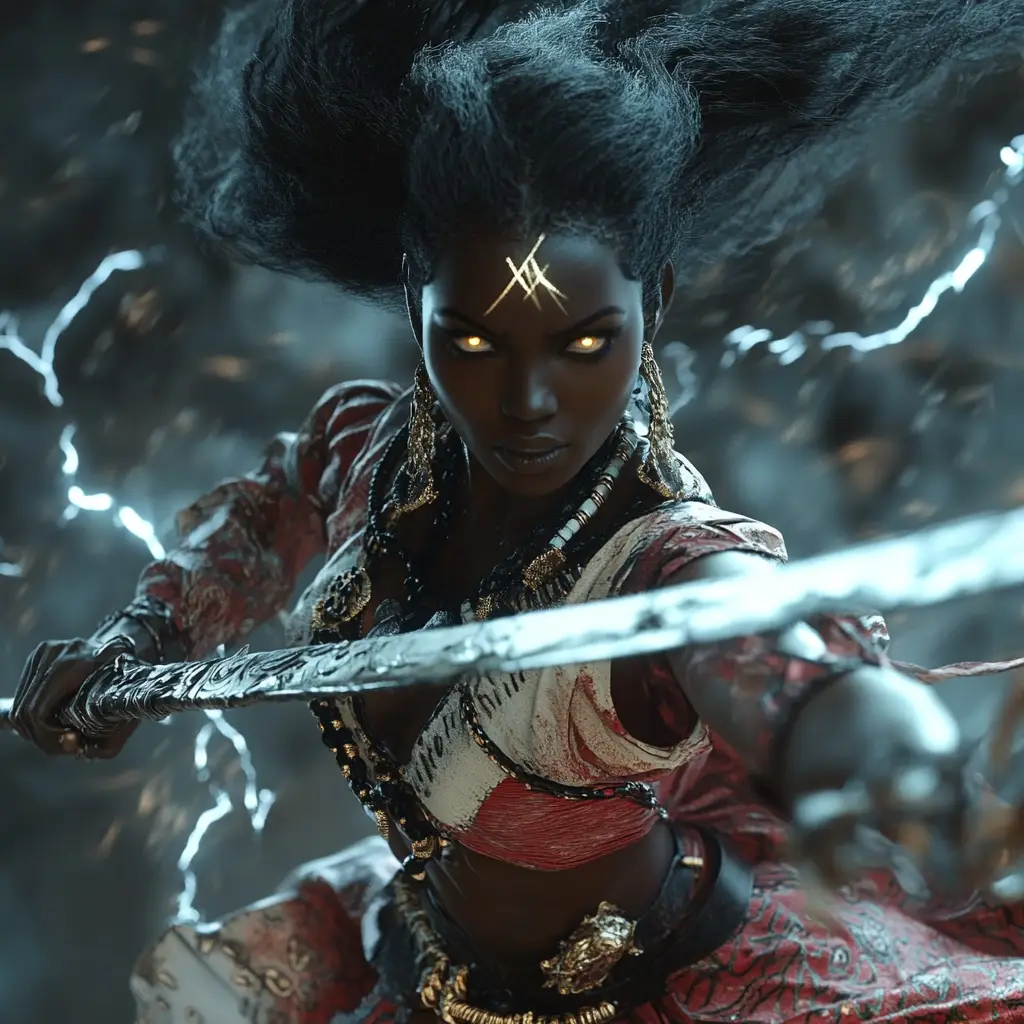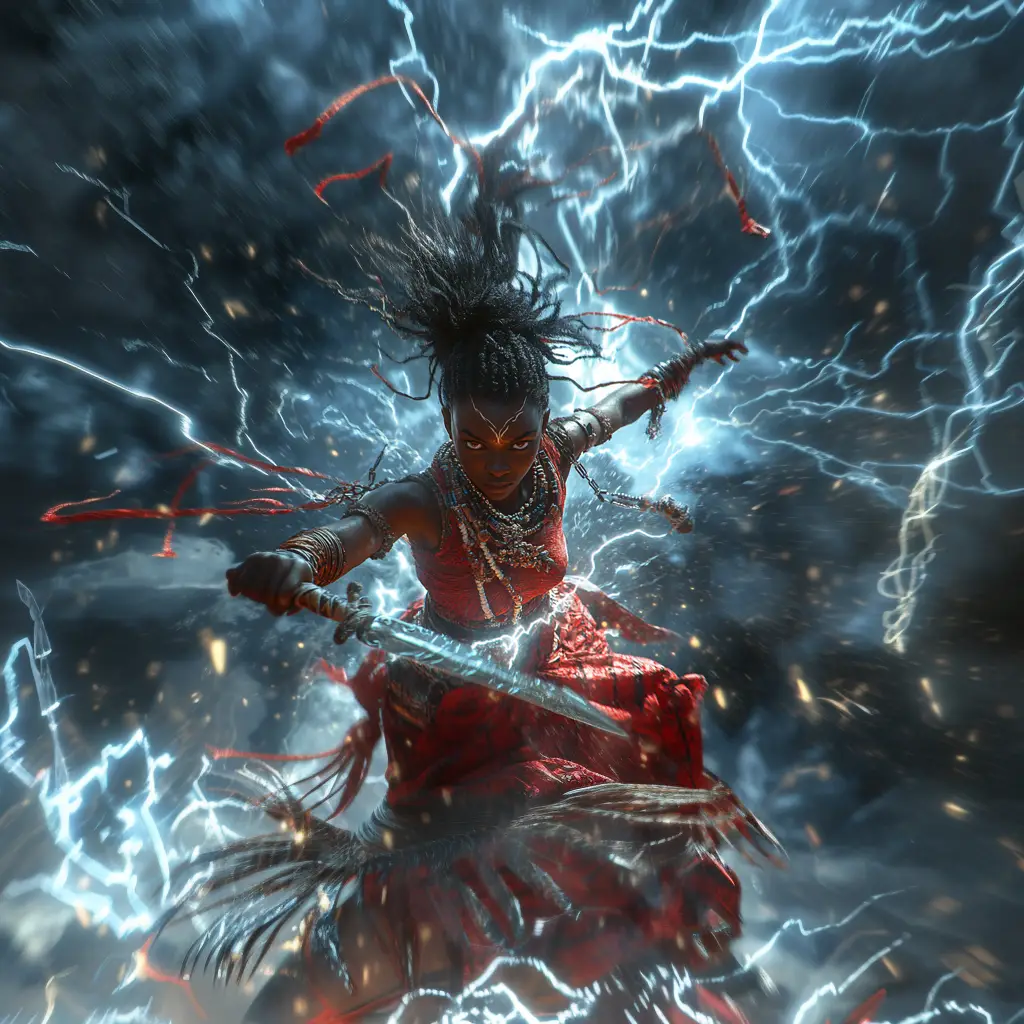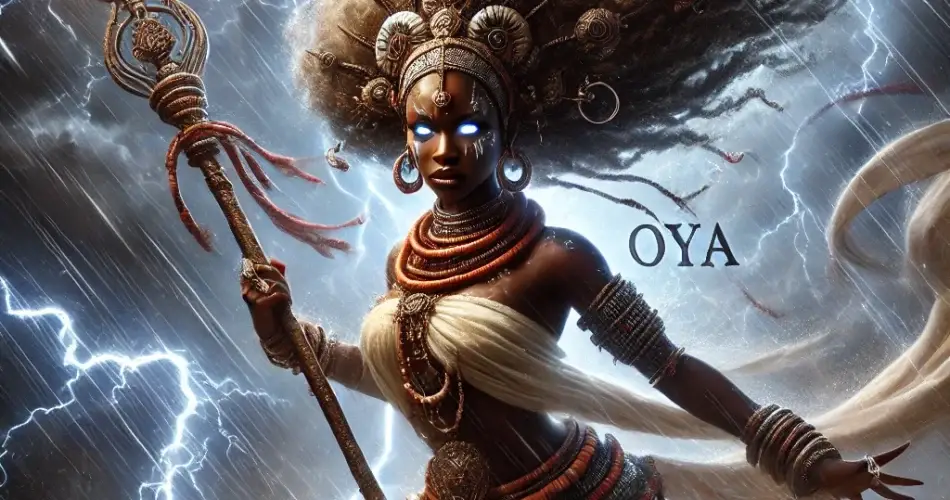In Yoruba mythology, Orisha Oya is the fierce and powerful goddess of winds, violent storms and lightning. Known as the guardian of the river Niger and the custodian of the newly dead to the Underworld.
Orisha Oya also embodies the force of nature and the spirit of change in the Yoruba culture.
Origin Story of Orisha Oya
Like many other orishas in Yoruba mythology, Orisha Oya’s origin story is complicated. This is due to the diverse cultural interpretations and oral traditions within the Yoruba religion and its diaspora. Some of these stories are explained below.
Oya and her three marriages

In One Story, it is said that Oya was a powerful mortal woman who was first married to Ogun, a warrior king who would later become the Yoruba god of war and iron. Although they loved each other, Ogun was always out in the field of war and was never around to meet his wife’s needs. His constant absence from home meant that Oya was always lonely and could not bear children. Fed up with the treatment, Oya left Ogun’s household and got married to Sango.
Oya’s decision to marry Sango caused a clash between Sango and Ogun, and the two men battled for seven days. On the seventh day, Ogun decided to release his wife to Sango; however, he cursed her that she would not bear any child for her new husband.
This curse came to pass as Oya was married to Sango for a long time without children. After an Ifa divination session, it was revealed to her that she would not bear children as long as she was married to Sango.
Although Oya loved Sango dearly, she desperately wanted children and decided to leave Sango and get married for the third time. This time, she got married to Oko, a very powerful and famous hunter. Oya’s marriage to Oko was more productive, and it is said that she gave birth to nine children in this marriage. This is why she is called “Iyansan” or “Iya Mesan,” meaning “Mother of Nine.”
Oya, as a forest Spirit
The most popular origin story of Orisha Oya is a story of love and betrayal. In this story, Oya is a forest spirit that loved to visit the human market every market day.
On one of these visits, Oya met Sango, and he immediately fell in love with her. Although Oya rejected all of Sango’s advances, he was not deterred and decided to stalk her. He did this and was able to discover her secret.
The next day, Oya visited the market again; however, Sango was ready. He sneaked into the forest and stole the animal skin that Oya needed to transform. When Oya returned, she looked for her animal skin everywhere without success.
At this point, Sango confessed to her. However, he refused to return the item to her unless she agreed to marry him. Knowing that she was trapped, Oya agreed to Sango’s demands on the condition that Sango would not reveal her secret to anyone. Sango also agreed to these terms.
Oya and Sango’s other Wives
At this time, Sango already had two wives, Oba and Oshun. When Sango brought Oya back home, they immediately became jealous of her beauty and started looking for ways to eliminate the new competition.
Initially, Sango kept Oya’s secret; however, as time passed, he became careless and let the secret slip to Oshun, who used the information to mock Oya during a fight.
Realising Sango had not kept his word, she left Sango’s house in anger and transformed into a river. It is believed that this river is what we now know as River Niger, or “Odo Oya”, meaning Oya’s river in Yoruba Language. Oya is worshipped as the spirit of the river today.
Oya, as the daughter of Yemoja
In another story, it is said that Oya and Sango are children of Yemoja, the Yoruba goddess of the Ocean and motherhood.
In some variations of this tale, Oya and Sango got married despite being siblings. However, this is very unlikely, and incest is considered sacrilegious in Yoruba land.
Powers and Characteristics of Orisha Oya

Oya is believed to have control over the winds and violent storms. She can summon hurricanes, tornados and powerful gusts of winds to sweep through the land. She is also associated with lightning and thunderstorms. It is believed that the spirit in the River Niger, which is more commonly known as Odo Oya in the Yoruba language.
She also plays a crucial role in the afterlife. According to Yoruba mythology, Oya guides the souls of the newly dead to the afterlife. Like the valkyries in Norse Mythology, the goddess collects the souls of those slain in war and guides them to the underworld. The goddess also watches over cemeteries and protects them from desecration. It is believed that Oya can save her followers from death and call death on her enemies.
Being Sango’s wife, it is believed that the two deities travel together and depend on each other. Before Sango goes to war, his wife, Oya, goes before him and uses her power over the winds and storms to disrupt and prepare the battlefield. After this, Sango comes around with his devastating thunder and firestorms.
The Unpredictable Nature of Oya
Unlike other Yoruba Orishas, who are either good or bad, Oya has a very unique reputation for being unpredictable and feisty. Just like the weather that she controls, the goddess is said to be loving, kind, and helpful to her followers. However, she can also be absolutely destructive and devastating to those who anger her.
Unlike her sister goddess Oshun, who has a more relaxed character, the goddess Oya is more aggressive, and the slightest offence can set her on a destructive rampage. Oya’s dual and unpredictable nature is seen in her name which is derived from the Yoruba phrase “O Ya,” which translates to “She tore.”
This interpretation of Oya provides a logical explanation of the unpredictable nature of weather in West Africa, where she is mainly worshipped.
Symbolism of the goddess Oya in Yoruba Culture

Oya is often represented as a beautiful, strong woman carrying a sword in her right arm and a flywhisk on the other hand. The sword represents Oya’s warrior spirit; she uses it to strike down her enemies and clear out obstacles for her followers. On the other hand, the flywhisk is used to summon the wind, lightning and other elements.
Modern depictions of Oya show her wearing nine different scarves; this symbolizes her nine children.
Oya is also worshipped as the goddess of transformation and change. During prolonged drought and famine, the Yoruba pray to the goddess to send rain and bring forth new growth on the land.
Finally, the goddess is described as a defender of women and the oppressed. When these people pray to her, she is swift to come to their aid and can be brutal to oppressors.
Worship of the goddess Oya
Oya is widely worshipped in West Africa, particularly in Nigeria and Benin, and in the Afro-Caribbean diaspora, including Brazil, Cuba, and Trinidad. In these regions, she is venerated through rituals that involve drumming, dancing, offerings, and chants. Devotees are required to make offerings of wine and eggplant, as well as Akara, a special bean cake made with a spherical patty made of peeled crushed black-eyed peas.
Oya’s sacred animals include the buffalo and the river horse; thus, devotees are forbidden to kill or eat these animals. Also, whistling indoors is forbidden as this can summon the wrath of the goddess of storms.
